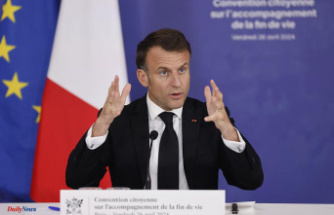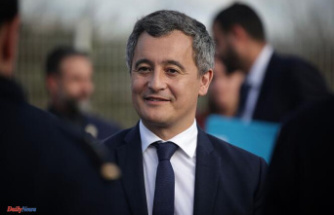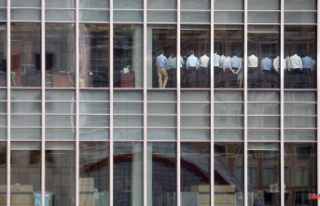For weeks there have been many indications of an imminent withdrawal of Russian troops from Cherson. Moscow is now officially announcing that it will give up the city. But what is behind it: Russia's further defeat or an elaborate trap? ntv.de answers the most important questions about the withdrawal of the Kremlin troops.
How did it happen that Russia had to withdraw its troops?
Kherson is the only Ukrainian regional capital that Russian troops have been able to capture since the invasion began. It is also one of the few major cities that the Russians have taken since February 24th. While the even larger Mariupol on the Sea of Azov and the smaller twin cities of Lysychansk and Sievjerodonetsk in the Luhansk region were almost completely destroyed in the fighting, Kherson is the only city that was captured intact. Already in the first days of the war, the invading troops from the Crimea reached the unprepared port city and took it almost without a fight.
But as early as March, the attackers in southern Ukraine got into trouble. In view of the fierce resistance of the Ukrainians, the Russians were unable to advance further from Kherson in the direction of Mykolaiv and Odessa.
All supplies to the Russian army in this area passed through a few bridges, all located in or near Kherson. Since the summer, after Kyiv received the long-range HIMARS missile systems from the US, the bridges became the main target of Ukrainian attacks, which worsened supplies for Russian troops. In recent months, the army and the population - Kherson had around 300,000 inhabitants before the war - were supplied exclusively with ferries and boats.
In the long run, the situation of the Russian army in Kherson seemed hopeless: the front line runs north of the city. The Russians can't break through because of the lack of supplies - because of the several hundred meters wide river in the south of the city. The Ukrainians cornered the Russians.
What is Russia losing by withdrawing?
If Russia withdraws its troops from the western bank of the Dnipro, it will no longer be able to attack the cities of Mykolaiv and Odessa. In addition, the entire Mykolayiv Oblast would come back under Ukrainian control. Russia currently controls about four percent of the region - about 1,000 square kilometers. Ukraine would also control around 23 percent of the Kherson Oblast, which Moscow believes has belonged to Russia since the annexation at the end of September. However, most of the region lies on the left bank of the Dnipro, north of Crimea.
Should the Ukrainians liberate Kherson, important Russian bases north of Crimea and even the city of Armyansk on the annexed peninsula would be within range of the HIMARS missiles.
What does the recapture of Cherson bring to Ukraine politically?
After the failure of the advance on Kyiv and the retreat at Kharkiv, this is seen as another military defeat for Russia and a great symbolic success for Ukraine. With this, Ukraine is sending an important signal to the West - it is worth continuing to support the country, comments ntv correspondent in Moscow, Rainer Munz.
What advantages does the withdrawal bring to the Russians?
Russian troops, including elite units such as the Paratroopers, previously stationed in the Kherson region can now be deployed elsewhere. The commander-in-chief of the "special operation" Sergey Surovikin announced on Wednesday that the units would be transferred to other sectors of the front when he suggested that Russian Defense Minister Sergey Shoigu withdraw from Kherson. The Donetsk region, where Russian troops have been fighting for months to capture the strategically important city of Bakhmut, could be the primary option.
How do people react in Russia?
Russian propaganda had been preparing the people for the retreat for weeks. The Presidential Administration distributed handbooks to state media workers on how to report on the situation. The withdrawal is only mentioned in passing on state television. There is talk of a "military necessity" and "regrouping of forces". In comments and reports, the propagandists compare the military leadership with Field Marshal Mikhail Kutuzov or Tsar Peter I. Both had to retreat with their armies for a long time - one in 1812 during Napoleon's Russian campaign, the other in 1709 in the Great Northern War, but at the end of the day stand out as a winner.
The best-known war hardliners - head of the Wagner mercenary group, Yevgeny Prigoshin, and Chechen leader Ramzan Kadyrov - defended the troop withdrawal. The commander Surovikin made a "difficult but correct decision between making senseless sacrifices for loud declarations and saving priceless soldiers' lives," Kadyrov wrote on Telegram. "This is not a step towards victory in this war. But it is important not to torture yourself and become paranoid now, but to draw conclusions and work on the mistakes," explained Prigozhin.
How do people react in Ukraine?
The news of the Russian withdrawal has met with mixed feelings in Ukraine. The leadership in Kyiv reacted skeptically to the Kremlin's announcement. "Ukraine sees no sign of Russia giving up Kherson without a fight," tweeted Presidential Office Advisor Mykhailo Podoliak. "Ukraine is liberating territories by relying on reconnaissance data and not on staged TV announcements," Podoliak continued. "The enemy doesn't give us gifts, doesn't make 'gestures of goodwill'," President Volodymyr Zelenskyy warned. Therefore, the Ukrainian army proceeds "very carefully, without emotions, without unnecessary risks".
Are the Russians gone yet? How is the situation on site?
According to their own statements, Ukrainian troops have advanced about seven kilometers on two sectors in Cherson and Mykolaiv since the announced Russian troop withdrawal. About 264 square kilometers and twelve towns were recaptured, said the supreme commander of the armed forces, Valeriy Saluschnyj, on Telegram. Pictures from the small town of Snihurivka in the Mykolaiv region were circulated in the morning.
How is the withdrawal going? What are the occupiers leaving behind?
According to British secret services, Russian troops are said to have destroyed bridges and presumably also laid mines in order to make it more difficult for Ukraine to recapture Cherson. It is to be expected that the announced withdrawal will last several days and will be accompanied by artillery fire to protect the withdrawing units, according to the daily situation report of the British Ministry of Defense on Thursday.
Could it be a trap?
Some observers actually see the Russian retreat as a trap. Reports have been mounting for weeks that Russian soldiers are disguising themselves as civilians and billeting in private houses. The Russian fighters appear to be ready for street fighting.
A few days ago - but before the withdrawal was announced - the spokeswoman for the southern command of the Ukrainian army, Nataliya Humenyuk, said on television that the occupiers were trying to create the impression that they were gone in order to lure Ukrainian forces to certain settlements in the region . Hard street fights are then to be provoked there.
What would the street fights in Kherson bring?
They would further complicate the recapture, and tie Ukrainian units in one place so that they cannot be deployed to other sectors of the front. According to estimates by German brigadier general Christian Freuding, winning a house-to-house battle in a big city requires an eight to tenfold superiority of the attacking forces - in this case the Ukrainians.
Should the Russians actually force street fighting on the Ukrainian forces, it could result in heavy casualties on the Ukrainian side. But the government in Kyiv has given the all-clear: "We know and anticipate the developments that the Russians want to force on us, and we are creating our own strategic plan," army spokeswoman Humenyuk said on television in early November.












